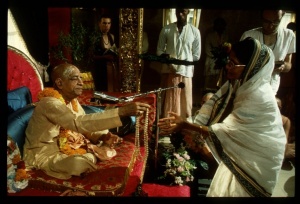CC Madhya 1.106: Difference between revisions
m (1 revision(s)) |
No edit summary |
||
| Line 1: | Line 1: | ||
{{ | [[Category:Sri Caitanya-caritamrta - Madhya-lila Chapter 01|C106]] | ||
<div style="float:left">'''[[Sri Caitanya-caritamrta|Śrī Caitanya-caritāmṛta]] - [[CC Madhya|Madhya-līlā]] - [[CC Madhya 1|Chapter 1: The Later Pastimes of Lord Śrī Caitanya Mahāprabhu]]'''</div> | |||
<div style="float:right">[[File:Go-previous.png|link=CC Madhya 1.105|Madhya-līlā 1.105]] '''[[CC Madhya 1.105|Madhya-līlā 1.105]] - [[CC Madhya 1.107|Madhya-līlā 1.107]]''' [[File:Go-next.png|link=CC Madhya 1.107|Madhya-līlā 1.107]]</div> | |||
{{CompareVersions|CC|Madhya 1.106|CC 1975|CC 1996}} | |||
{{RandomImage}} | |||
==== TEXT 106 ==== | ==== TEXT 106 ==== | ||
<div | <div class="verse"> | ||
tabe ta’ pāṣaṇḍi-gaṇe karila dalana | :tabe ta’ pāṣaṇḍi-gaṇe karila dalana | ||
ahovala-nṛsiṁhādi kaila daraśana | :ahovala-nṛsiṁhādi kaila daraśana | ||
</div> | </div> | ||
| Line 12: | Line 16: | ||
==== SYNONYMS ==== | ==== SYNONYMS ==== | ||
<div | <div class="synonyms"> | ||
tabe | ''tabe ta’''—thereafter; ''pāṣaṇḍi-gaṇe''—unto the atheists; ''karila''—did; ''dalana''—subduing; ''ahovala-nṛsiṁha-ādi''—Nṛsiṁhadeva, named Ahovala or at Ahovala; ''kaila''—did; ''daraśana''—visit. | ||
</div> | </div> | ||
| Line 19: | Line 23: | ||
==== TRANSLATION ==== | ==== TRANSLATION ==== | ||
<div | <div class="translation"> | ||
After visiting the temples of Tirumala and Tirupati, Śrī Caitanya Mahāprabhu had to subdue some atheists. He then visited the temple of Ahovala-nṛsiṁha. | After visiting the temples of Tirumala and Tirupati, Śrī Caitanya Mahāprabhu had to subdue some atheists. He then visited the temple of Ahovala-nṛsiṁha. | ||
</div> | </div> | ||
| Line 26: | Line 30: | ||
==== PURPORT ==== | ==== PURPORT ==== | ||
<div | <div class="purport"> | ||
The Ahovala temple is situated in Dākṣiṇātya, in the district of Karṇula, within the subdivision of Sārbela. Throughout the whole district this very famous temple is much appreciated by the people. There are eight other temples also, and all of them together are called the Nava-nṛsiṁha temples. There is much wonderful architecture and artistic engraving work in these temples. However, as stated in the local gazette, the Karṇula Manual, the work is not complete. | The Ahovala temple is situated in Dākṣiṇātya, in the district of Karṇula, within the subdivision of Sārbela. Throughout the whole district this very famous temple is much appreciated by the people. There are eight other temples also, and all of them together are called the Nava-nṛsiṁha temples. There is much wonderful architecture and artistic engraving work in these temples. However, as stated in the local gazette, the ''Karṇula Manual'', the work is not complete. | ||
</div> | </div> | ||
__NOTOC__ | |||
<div style="float:right; clear:both;">[[File:Go-previous.png|link=CC Madhya 1.105|Madhya-līlā 1.105]] '''[[CC Madhya 1.105|Madhya-līlā 1.105]] - [[CC Madhya 1.107|Madhya-līlā 1.107]]''' [[File:Go-next.png|link=CC Madhya 1.107|Madhya-līlā 1.107]]</div> | |||
__NOTOC__ | |||
__NOEDITSECTION__ | |||
Revision as of 02:28, 23 July 2021

A.C. Bhaktivedanta Swami Prabhupada
TEXT 106
- tabe ta’ pāṣaṇḍi-gaṇe karila dalana
- ahovala-nṛsiṁhādi kaila daraśana
SYNONYMS
tabe ta’—thereafter; pāṣaṇḍi-gaṇe—unto the atheists; karila—did; dalana—subduing; ahovala-nṛsiṁha-ādi—Nṛsiṁhadeva, named Ahovala or at Ahovala; kaila—did; daraśana—visit.
TRANSLATION
After visiting the temples of Tirumala and Tirupati, Śrī Caitanya Mahāprabhu had to subdue some atheists. He then visited the temple of Ahovala-nṛsiṁha.
PURPORT
The Ahovala temple is situated in Dākṣiṇātya, in the district of Karṇula, within the subdivision of Sārbela. Throughout the whole district this very famous temple is much appreciated by the people. There are eight other temples also, and all of them together are called the Nava-nṛsiṁha temples. There is much wonderful architecture and artistic engraving work in these temples. However, as stated in the local gazette, the Karṇula Manual, the work is not complete.